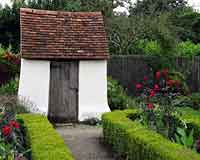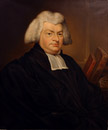|
|||||||||||||||||||||||
|
In 1767 Cowper and the Unwin household left Huntingdon for Orchard Side in Olney, Buckinghamshire, following the death of the Rev. Morley Unwin. This was at the suggestion of the Rev. John Newton. This remarkable man was an ex-slaveship captain turned ordained Anglican minister. Newton and his wife Mary became firm and loyal friends of William Cowper and Mary Unwin. Olney at that time had a population of around two thousand and about five hundred houses. Cowper wrote: Olney is a populous place, inhabited chiefly by the half starved and ragged of the Earth. Newton had been equally forthright when he first arrived in 1764: The people here are mostly poor the country low and dirty. But he was full of plans to help: The poor ignorant lacemakers For Olney was an old lace town; of the population 1200 were employed at making bobbin or pillow lace. Women spent up ten to twelve hours a day making lace so gangs of "ilI-fed child savages" roamed the streets getting into all manner of mischief. Newton's patron, John Thornton, gave him £200 per annum to keep open house and to distribute to the poor and needy. In this work Newton was helped by Cowper who became a sort of lay-curate visiting the sick and dying and helping to distribute funds. To the local people he became 'Squire Cowper' or 'Sir Cowper'.... In the garden of Orchard Side there is a tiny building "not much bigger than a sedan chair". Cowper called it his Sulking Room and he spent much time there. Built by the previous owner, Thomas Aspray, as a Smoking Room, it continued to serve the same purpose when Newton joined Cowper there. The ground between Newton's vicarage garden and Cowper's garden belonged to Mrs Aspray and our two friends paid her a guinea a year for the right of way; it is still called Guinea Field today.In 1769 Mrs Unwin was seriously ill and Cowper became very distressed at the thought that he might lose
Apart from organising the practicalities of life which were beyond Cowper, Mary Unwin was an intelligent and sympathetic companion. She was deeply religious and although only some twelve or so years older than Cowper he seems almost to regard her as a surrogate mother figure or at least an older sister. He wrote 'Oh for a closer walk with God' at this time. Fortunately, Mary recovered. In the same year Newton moved his weekly prayer meetings to the Great House to accommodate more people and ... a desire of promoting the faith and comfort of sincere Christians. For the first gathering Cowper wrote 'Jesus where're thy people meet'. Newton now suggested a collaboration of hymn writing to expound the weekly texts. These were later published as the Olney Hymns in 1779. There are 348 hymns of which Cowper wrote some 66 between 1772 and 1773 while Newton wrote the remaining 282, of which the most famous of his is probably 'Amazing Grace'. William Unwin had become rector of Stock in Essex in 1769 and his visits to Olney were infrequent. In 1770 William's brother died and he left Cowper a small legacy. It was suggested by well meaning individuals that Cowper and Mary should marry and indeed they became engaged later that year. His mental health deteriorated under the strain. He had terrible nightmares and believed God had rejected him. He moved to the Vicarage to avoid the Olney Cattle Fair which took place near Orchard Side and the week's stay turned into fourteen months. Another suicide attempt was made; at first he refused to take his medication but his cousin Judith Madan persuaded him to take those she recommended. He again was treated by Dr. Cotton and gradually recovered. In the aftermath of his illness the engagement was broken off. In 1774 Susannah Unwin left Orchard Side to marry the Rev. Matthew Powley, thereby leaving her mother unchaperoned but no more was said about his possible marriage to Mary Unwin. On his return to Orchard Side he was glad "of anything that would engage my attention without fatiguing it". Some neighbour's children had a leveret of which they grew tired. Cowper was offered this and two others. In a letter dated 28th May 1784 Cowper describes the arrangements he made for his pets.
A memorandum found among Cowper's papers dated 9th March 1786 records the last of his three hares.
Cowper's recovery was sufficient to allow him to resume his correspondence. An avid and stylish writer, his letters of this period are full of anecdotes about the garden and greenhouse and his experiments in growing melons, cucumbers and pineapples. John Newton introduced Cowper to his friend the Rev William Bull, an Independent minister at Newport Pagnell. Bull began to ride over every week; Bull smoked and the loose floorboard in the Sulking Room (Summer House) became a hidey-hole for Bull's pipes and tobacco.
In the winter of 1779/1780 Newton left Olney to become Rector of St. Mary Woolnoth Church in the City of London. Cowper and Newton continued their friendship by letter and with occasional visits. With Newton gone, the money that Newton had distributed around Olney ceased and conditions worsened as was made plain by Cowper in a letter to Joseph Hill dated 8th July 1780:
Poetry rather than hymn writing occupied Cowper during this period.
Mary Unwin encouraged him in this and in 1782 a volume of poems was published. Newton's replacement was Rev. Thomas Scott, who let the first floor of the vicarage to Lady Austen, the sister-in-law to Rev Jones of Clifton Reynes. In such a small society she and Cowper soon met and a warm friendship began. She also encouraged him with his verses. She recounted an amusing anecdote which Cowper turned into his comic narrative of John Gilpin. This was published at first anonymously but the author was soon identified and this more than any other work made Cowper's name with the public. Anne Austen, a widow, fell in love with Cowper and he on his part enjoyed her wit and company. Were it not for Mary Unwin's years of devotion and support, he may have reciprocated. Anne Austen left for Bath in 1784 if not exactly spurned then disappointed. She however is credited for instigating and inspiring Cowper with his major work "The Task". This had a profound influence on contemporary poets and was a precursor of the Romantic movement.
|
|
||||||||||||||||||||||
|
|||||||||||||||||||||||





